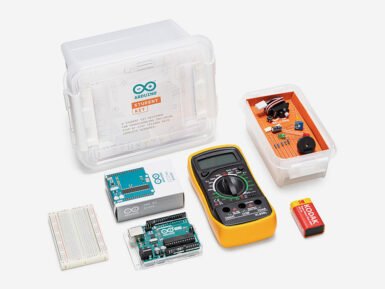
Overview
The sensor consists of an IR LED and a photo sensor (phototransistor). The light emitted by the IR LED gets reflected by any object placed in front of the sensor and this reflection is detected by the photo sensor (phototransistor). Any white (or lighter) colored surface reflects more than black (or darker) colored surface.
When the reflected light is detected, it produces Digital HIGH (or Binary 1) output on the Sig pin. The on-board LED indicator will also glow. If no reflection is detected or if the object is too far from the sensor, the output on the SIG pin stays at Digital LOW (Binary 0). The on-board LED indicator will be off as well.
The detectable range of this sensor is 4–16 mm. The module incorporates a Rail-to-Rail Operational Amplifier to amplify the output of phototransistor. There is a potentiometer which can be used to adjust the gain of the amplifier, that is, sensitivity of detection.
Get Inspired

Schools have recently had to make a sudden and seismic shift in the way they teach. As both educators and students get used to remote learning, the onus is now more on parents to support their children through homeschool, and that means parents themselves need support. At Arduino Education, we want to help you and your children by making remote learning experiences as smooth (and fun!) as possible. Learning electronics and coding at home As parents to children aged 11-plus, learning electronics and coding with them at home may not be something you’d ever think you’d be doing. But don’t worry, it really isn’t as daunting as it sounds, and electronics and coding skills are crucial in the world your children are growing up in. About electronics and coding Learn coding and the basic concepts of electricity together with your child at home with the Arduino Student Kit. It comes with all of the electronic components you need, as well as step-by-step instructions for how to start coding. But what is coding, exactly? Well, it’s simply the language that computers understand. It’s how we tell a computer what to do. In the Student Kit, you get pre-programmed code to help you understand how it works. You could also explore drag-and-drop visual coding such as Scratch to help you get a better understanding of what coding is. Learn electronics and coding at home with the Arduino Student Kit The Student Kit is a hands-on, step-by-step homeschool starter kit for children aged 11-plus that will help them get started with the basics of electronics and coding at home. You’ll get all the hardware and software you need for one person, as well as complete guidance, step-by-step lessons, exercises, and a logbook where you can answer the lesson questions and find solutions. How the kit helps you homeschool your children This is your hands-on, step-by-step remote learning tool that will help your child learn the basics of programming, coding, and







